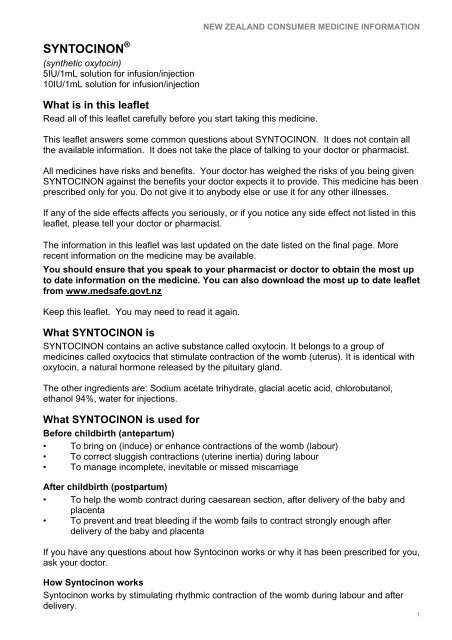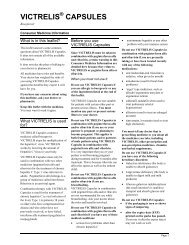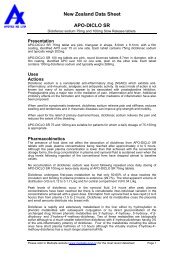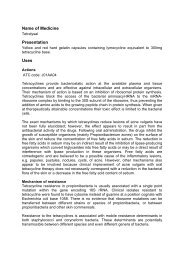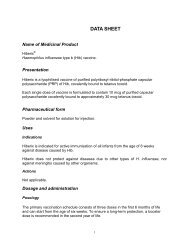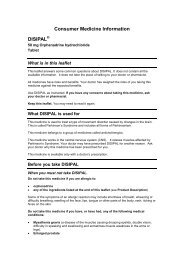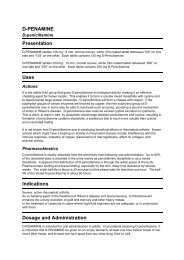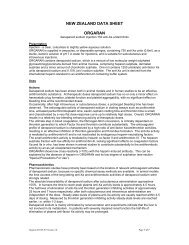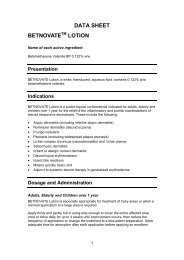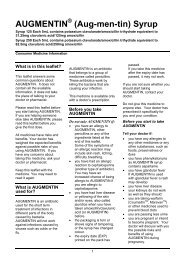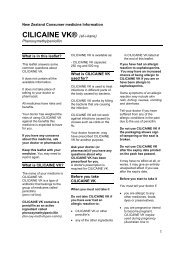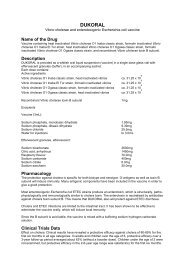SYNTOCINON - Medsafe
SYNTOCINON - Medsafe
SYNTOCINON - Medsafe
Create successful ePaper yourself
Turn your PDF publications into a flip-book with our unique Google optimized e-Paper software.
<strong>SYNTOCINON</strong> ®<br />
(synthetic oxytocin)<br />
5IU/1mL solution for infusion/injection<br />
10IU/1mL solution for infusion/injection<br />
NEW ZEALAND CONSUMER MEDICINE INFORMATION<br />
What is in this leaflet<br />
Read all of this leaflet carefully before you start taking this medicine.<br />
This leaflet answers some common questions about <strong>SYNTOCINON</strong>. It does not contain all<br />
the available information. It does not take the place of talking to your doctor or pharmacist.<br />
All medicines have risks and benefits. Your doctor has weighed the risks of you being given<br />
<strong>SYNTOCINON</strong> against the benefits your doctor expects it to provide. This medicine has been<br />
prescribed only for you. Do not give it to anybody else or use it for any other illnesses.<br />
If any of the side effects affects you seriously, or if you notice any side effect not listed in this<br />
leaflet, please tell your doctor or pharmacist.<br />
The information in this leaflet was last updated on the date listed on the final page. More<br />
recent information on the medicine may be available.<br />
You should ensure that you speak to your pharmacist or doctor to obtain the most up<br />
to date information on the medicine. You can also download the most up to date leaflet<br />
from www.medsafe.govt.nz<br />
Keep this leaflet. You may need to read it again.<br />
What <strong>SYNTOCINON</strong> is<br />
<strong>SYNTOCINON</strong> contains an active substance called oxytocin. It belongs to a group of<br />
medicines called oxytocics that stimulate contraction of the womb (uterus). It is identical with<br />
oxytocin, a natural hormone released by the pituitary gland.<br />
The other ingredients are: Sodium acetate trihydrate, glacial acetic acid, chlorobutanol,<br />
ethanol 94%, water for injections.<br />
What <strong>SYNTOCINON</strong> is used for<br />
Before childbirth (antepartum)<br />
• To bring on (induce) or enhance contractions of the womb (labour)<br />
• To correct sluggish contractions (uterine inertia) during labour<br />
• To manage incomplete, inevitable or missed miscarriage<br />
After childbirth (postpartum)<br />
• To help the womb contract during caesarean section, after delivery of the baby and<br />
placenta<br />
• To prevent and treat bleeding if the womb fails to contract strongly enough after<br />
delivery of the baby and placenta<br />
If you have any questions about how Syntocinon works or why it has been prescribed for you,<br />
ask your doctor.<br />
How Syntocinon works<br />
Syntocinon works by stimulating rhythmic contraction of the womb during labour and after<br />
delivery.<br />
1
Monitoring Syntocinon treatment<br />
During Syntocinon infusion, both you and your baby will be closely monitored to prevent<br />
complications so that the dosage can be adjusted to the individual response.<br />
Before receiving Syntocinon<br />
Follow all the doctor’s instructions carefully. They may differ from the general information<br />
contained in this leaflet.<br />
It is important to tell your doctor if you have other medical problems or if you are taking other<br />
medicines.<br />
Syntocinon should not be used:<br />
• If you are allergic (hypersensitive) to oxytocin or to any of the ingredients of<br />
Syntocinon listed at the end of the leaflet under What Syntocinon is<br />
• If your doctor thinks that inducing or enhancing contractions would be unsuitable for<br />
you. For example:<br />
- If you already have unusually strong (hypertonic) contractions<br />
- If your baby is short of oxygen (foetal distress) and delivery is not imminent<br />
- If your doctor advises against normal labour and/or vaginal delivery<br />
• If there are maternal or foetal reasons for caesarean delivery. For example:<br />
- If your baby’s head is too large to fit through your pelvis (cephalopelvic<br />
disproportion)<br />
- If your baby is wrongly positioned in the birth canal (malpresentation)<br />
- If the placenta lies near or over the neck of your womb (placenta praevia)<br />
- If your baby lacks oxygen due to blood vessels running across the neck of your<br />
womb (vasa praevia)<br />
- If the placenta separates from the womb before the baby is born (abruption)<br />
- If there are one or more loops of umbilical cord between the baby and neck of the<br />
womb, before your waters break (cord presentation) or afterwards (cord prolapse).<br />
- If your womb is over-extended and more liable to burst (rupture), for example if you<br />
are carrying more than one baby (multiple pregnancy) or have too much water<br />
(amniotic fluid) in your womb (polyhydramnios)<br />
- If you have had five or more previous pregnancies (grand multiparity) or if your<br />
womb is scarred by a previous caesarean section or other surgery<br />
- If you have been given medicines called prostaglandins (used to bring on [induce]<br />
labour or treat stomach ulcers). Syntocinon should not be used for 6 hours after<br />
vaginal prostaglandins as the effects of both drugs may be increased<br />
If any of these apply to you, you should not receive Syntocinon and you should consult your<br />
doctor.<br />
If you think you may be allergic, ask your doctor for advice.<br />
Take special care with Syntocinon<br />
Syntocinon should be administered by a health care professional. It should be administered<br />
in a hospital setting where a qualified health care professional can monitor your contractions<br />
and handle emergencies appropriately<br />
Syntocinon should not be used for prolonged periods<br />
• If it fails to increase your contractions (oxytocin-resistant uterine inertia)<br />
• If you have high blood pressure, protein in the urine and swelling (pre-eclamptic<br />
toxaemia)<br />
• If you have severe heart and/or circulation problems (severe cardiovascular disease)<br />
2
Syntocinon should be used with caution<br />
• If you are prone to chest pain (angina, caused by insufficient blood flow to heart) due<br />
to pre-existing heart and/or circulation problems (cardiovascular disease)<br />
• If you have a known irregular heart beat (‘long QT syndrome’) or related symptoms, or<br />
are taking medicines known to cause the syndrome<br />
• If you are given a rapid intravenous injection (bolus), it may cause decreased blood<br />
pressure (hypotension), a sudden brief sensation of heat (flushing), often over the<br />
entire body, and an increased heart rate (reflex tachycardia)<br />
When Syntocinon is given to induce and enhance labour:<br />
• It should be given only by intravenous infusion<br />
• The infusion rate should be set to maintain a contraction pattern similar to normal<br />
labour and adjusted to individual response. Excessive doses may cause very strong<br />
continuous contraction (tetany) and possible bursting (rupture) of the womb with<br />
serious complications for your baby (distress or death) and yourself<br />
Take particular care with Syntocinon:<br />
• If you have been warned by a doctor or midwife that normal delivery may be difficult as<br />
your baby’s head may be too large to fit through your pelvis (cephalopelvic<br />
disproportion)<br />
• If your womb starts to contract less strongly during labour (secondary uterine inertia)<br />
• If you have a mild or moderate pregnancy-induced increase in blood pressure or heart<br />
and/or circulation problems (cardiovascular disease)<br />
• If you are over 35 years of age<br />
• If you have had a caesarean section through an incision just above the edge of the<br />
bladder (lower segment caesarean section)<br />
• If you have kidney problems (Syntocinon can cause water retention)<br />
If any of these conditions apply to you, tell your doctor as soon as possible.<br />
• Syntocinon may rarely cause abnormal blood clotting, bleeding and anaemia<br />
(disseminated intravascular coagulation)<br />
• High doses of Syntocinon may force water from your womb (amniotic fluid) into your<br />
blood circulation (amniotic fluid embolism) during labour and/or delivery<br />
• High doses of Syntocinon over a prolonged period while drinking or receiving large<br />
volumes of fluid may cause<br />
- severe abdominal fullness and difficulty in breathing (acute pulmonary oedema)<br />
- a low level of salt (sodium) in the blood (hyponatraemia)<br />
Taking other medicines<br />
Tell your doctor or health care professional about the other medicines you are taking or have<br />
recently taken, including those you may have bought over the counter. It is especially<br />
important that your doctor knows if you are receiving any of the following:<br />
• Anaesthetic medicines for local or regional pain relief, in particular epidural<br />
anaesthesia (injection of local anaesthetic around the spinal cord) for pain relief during<br />
labour: Syntocinon may increase the blood vessel narrowing effect of these medicines<br />
(vasoconstriction), and cause an increase in blood pressure<br />
• Medicines called prostaglandins (used to bring on [induce] labour or treat stomach<br />
ulcers) and similar drugs: Syntocinon may increase their contractile effect on your<br />
womb<br />
• Medicines that can cause an irregular heart beat (prolonged QT interval): Syntocinon<br />
may increase this effect<br />
• Gas or vaporous liquid anaesthetics that cause general anaesthesia when inhaled<br />
(such as halothane, cyclopropane, sevoflurane or desflurane) may weaken the<br />
contractile effects of Syntocinon on your womb<br />
3
Elderly (65 years and over)<br />
There is no information on use in elderly patients. Syntocinon is not intended for use in the<br />
elderly<br />
Children and adolescents (2 years to 17 years)<br />
There is no information on use in children (2-11 years). Syntocinon is not intended for use in<br />
children.<br />
There is no information on use in adolescents (12-17 years). Syntocinon is not intended for<br />
use in adolescents<br />
Pregnancy<br />
Based on wide experience with the drug, its chemical structure and pharmacological<br />
properties, Syntocinon is not expected to present a risk to the baby when used as indicated.<br />
It should only be used to initiate labour under medical supervision.<br />
Breast-feeding<br />
Syntocinon may be found in small quantities in breast milk but is not expected to have<br />
harmful effects because it is rapidly inactivated by your baby’s digestive system. This<br />
explains why Syntocinon is safe for your newborn baby.<br />
Driving and using machines<br />
Syntocinon may induce contractions. Caution should therefore be exercised when driving or<br />
operating machines. Women with contractions should not drive or use machines.<br />
How to use Syntocinon<br />
Syntocinon should be administered as an infusion or injection into a vein. It should be<br />
administered in a hospital setting where a qualified health care professional can monitor your<br />
contractions. See also the section Take special care with Syntocinon.<br />
How much Syntocinon to use<br />
Your doctor or health care professional will decide how much Syntocinon to use. For more<br />
information please refer to section 7: Information for the health care professional.<br />
When to use Syntocinon<br />
Your doctor will decide when to use Syntocinon. You should check with your doctor or health<br />
care professional for more information. If you have the impression that the effect of<br />
Syntocinon is too strong or too weak, talk to your doctor or health care professional.<br />
How to use Syntocinon<br />
Syntocinon is usually diluted before use and given as an intravenous infusion (drip) or<br />
injection by a health care professional.<br />
How long to use Syntocinon<br />
Your doctor will decide how long you should use Syntocinon. If you are unsure, ask your<br />
doctor or health care professional.<br />
If you have received more Syntocinon than you should<br />
As this medicine is given to you in hospital, it is very unlikely that you will receive an<br />
overdose. Were it to happen, however, it is an emergency that can be handled immediately in<br />
the hospital setting.<br />
4
Anyone accidentally receiving this medicine should visit a hospital accident and emergency<br />
department or doctor immediately, if possible with the left-over medicines or empty packet.<br />
Excessive contractions caused by an overdose of Syntocinon may have the consequences<br />
mentioned in the sections ‘Take special care with Syntocinon’ and ‘Possible side effects’:<br />
• The placenta may separate too early from the womb (abruption)<br />
• Some of the water around your baby (amniotic fluid) may be forced into your<br />
circulation (amniotic fluid embolism)<br />
• Your baby may suffer distress, suffocation or death<br />
• Your womb may tear or burst (rupture)<br />
If you forget to use Syntocinon<br />
As you will only be given this medicine by a doctor or health care professional, you are<br />
unlikely to miss a dose.<br />
If you have any further questions on the use of this product, ask your doctor or health care<br />
professional.<br />
If you stop using Syntocinon<br />
Your doctor will decide when you should stop treatment with Syntocinon. If you are unsure,<br />
ask your doctor or health care professional.<br />
Possible side effects<br />
As with all medicines, side effects may occur with Syntocinon, although not everybody gets<br />
them. Your doctor may consider it necessary to treat the side effects of Syntocinon with other<br />
medicines.<br />
Some side effects could be serious.<br />
Some side effects are rare<br />
The following side effect may affect between 1 and 10 in every 1,000 patients:<br />
• Severe allergic (anaphylactoid) reaction associated with breathlessness (dyspnoea),<br />
low blood pressure (hypotension) or dangerously low blood pressure (shock)<br />
The proportion of patients who may be affected by the following serious side effects is<br />
unknown:<br />
Effects in the mother<br />
• Chest pain due to insufficient blood flow to the heart (angina)<br />
• Irregular heartbeat (long QTc interval)<br />
• Excessive contractions (hypertonicity)<br />
• Continuous contraction (tetany)<br />
• Bursting of the womb (uterine rupture)<br />
• Fluid retention (water intoxication)<br />
• Low sodium (salt) level in the blood (hyponatraemia)<br />
• Acute fluid overload in the lungs (acute pulmonary oedema)<br />
• A sudden brief sensation of heat, often over the entire body (flushing)<br />
• Abnormal clotting, bleeding and anaemia (disseminated intravascular coagulation)<br />
If you experience any of these, tell your doctor straight away.<br />
Effects in the baby<br />
Excessive contractions may cause:<br />
• Low sodium (salt) level in the blood (neonatal hyponatraemia)<br />
• Oxygen starvation (foetal distress)<br />
5
• Suffocation from too little oxygen and/or too much carbon dioxide (asphyxia)<br />
• Death<br />
If any of these affects are severe, tell your doctor straight away.<br />
Some side effects are common<br />
These side effects may affect between 1 and 10 in every 100 patients.<br />
• Headache<br />
• Fast heart beat (tachycardia)<br />
• Slow heart beat (bradycardia)<br />
• Nausea<br />
• Vomiting<br />
If any of these affects you severely, tell your doctor.<br />
Some side effects are uncommon<br />
This side effect may affect between 1 and 10 in every 1,000 patients.<br />
• Irregular heartbeat (arrhythmia)<br />
If any of these affects you severely, tell your doctor.<br />
Some side effects are rare.<br />
This side effect may affect between 1 and 10 in every 10,000 patients.<br />
• Skin rash<br />
If any of these affects you severely, tell your doctor.<br />
If you notice any other side effects not mentioned in this leaflet, please inform your doctor or<br />
pharmacist.<br />
Storing Syntocinon<br />
Store in a refrigerator (2-8°C). Keep Syntocinon out of the reach and sight of children.<br />
Supplier<br />
<strong>SYNTOCINON</strong> is supplied in New Zealand by:<br />
Novartis New Zealand Limited<br />
Private Bag 65904<br />
Mairangi Bay<br />
Auckland<br />
Building G, 5 Orbit Drive<br />
Rosedale<br />
Auckland 0632<br />
Telephone 0800 652 422<br />
This leaflet was prepared in July 2012<br />
6


